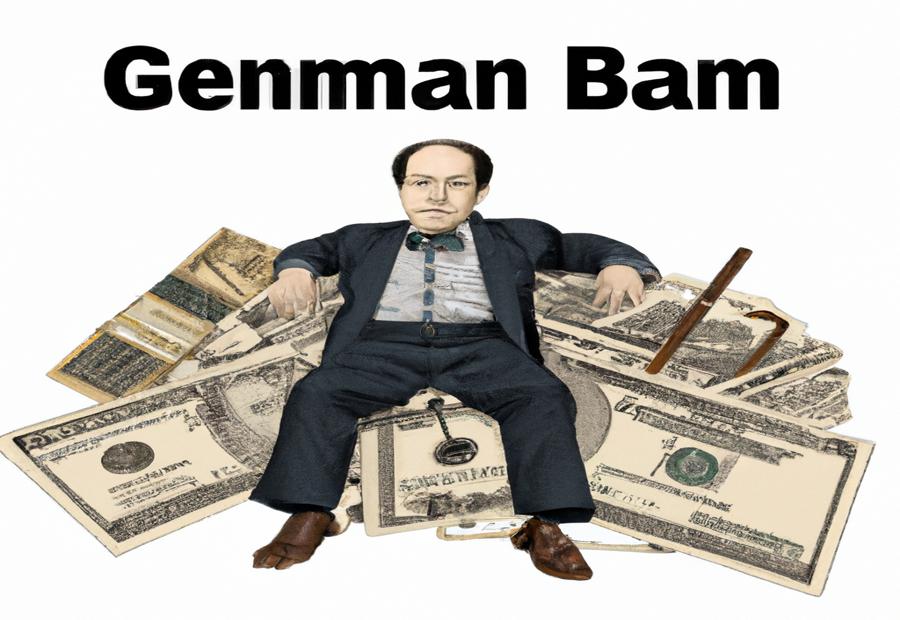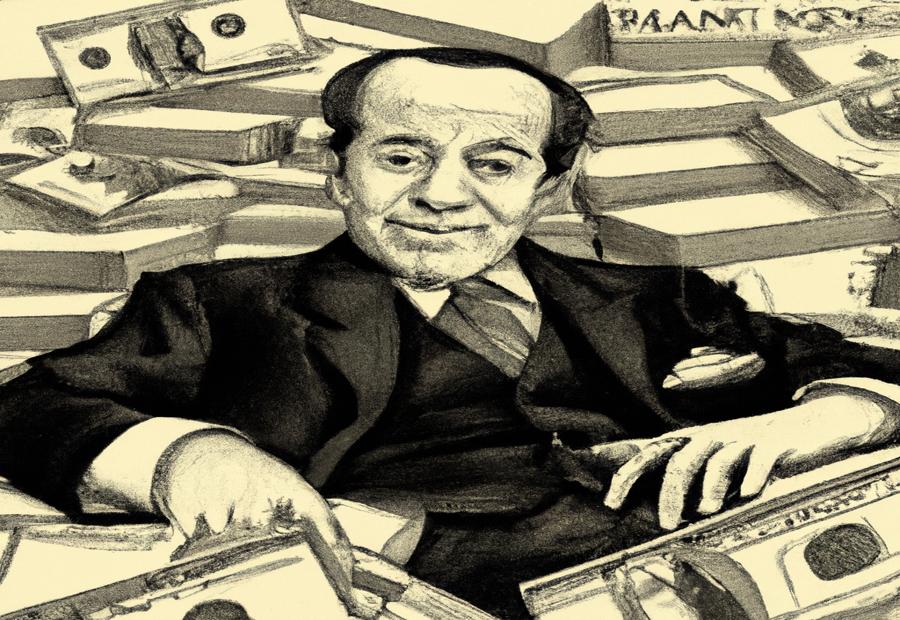.jpg)
Key Takeaways:
- Benjamin Graham’s investment philosophy was rooted in value investing principles, which emphasized the importance of buying undervalued stocks with growth potential.
- Graham’s successful investments, such as his investment in AT&T, resulted in average annualized returns from 1936 to 1956.
- His contributions to investing include authoring influential books, teaching at Columbia University, and influencing other successful investors.
- While Benjamin Graham’s exact net worth at the time of his death is unknown, his financial success can be attributed to various factors such as his investment strategies and wise financial decisions.
- Benjamin Graham’s legacy continues to have a significant impact on the field of investing, with the development of value investing and ongoing debates about the effectiveness of his investment strategies.
Benjamin Graham’s Background and Career

Photo Credits: Bizstone.Com by Juan Scott
Benjamin Graham, a legendary figure in the finance world, had a remarkable background and career worth exploring. From his early life and immigration to the United States to his education and work experience, each aspect shaped his path to success. Additionally, his establishment of the Graham-Newman Partnership marked a pivotal moment in his career. Join me as we uncover the fascinating journey of Benjamin Graham and understand how his background laid the foundation for his immense net worth.
Early life and immigration to the United States
Benjamin Graham’s early life began in Europe during a time of social unrest. Consequently, he bravely chose to make the journey to the United States for a new opportunity. His education and work experience provided him with the skills to excel in the investment industry.
In the US, he created the Graham-Newman Partnership. This gave him the chance to explore his investment philosophy and use his value investing approach. He also gained relationships with finance professionals.
However, while in the US, Graham encountered financial difficulties. Despite this, he gained valuable lessons which shaped his view on investing. These experiences informed his strategy to find stocks with growth potential.
Education and work experience
Benjamin Graham’s success in investing was heavily influenced by his educational background and work experience. He graduated from Columbia University with a degree in economics, and achieved remarkable academic results. He also gained knowledge from his time at Newburger, Henderson & Loeb – a well-known Wall Street firm. This gave him insights into investment strategies and market trends.
At Newburger, Henderson & Loeb, he learnt how to carefully analyze balance sheets and financial statements. This experience helped him to identify stocks that could be bought cheaply and then sold at a higher price later. In addition, he realized the importance of considering both quantitative and qualitative factors when investing.
Graham’s work didn’t just involve Wall Street; he was also an instructor at Columbia University. Here, he taught investment principles and security analysis. This enabled him to share his wisdom and mentor future investors, thus helping to promote value investing as an investment philosophy.
Establishment of Graham-Newman Partnership
Benjamin Graham’s Graham-Newman Partnership was established to utilize his financial knowledge and experience. Immigrating to the United States early on, Graham brought fresh perspectives on value investing. He recognized undervalued stocks with growth potential, setting the tone for successful investments. Graham’s own financial hardship and admiration of successful investors inspired the partnership.
This marked an important milestone in Benjamin Graham’s career and contributions to investing. His expertise in value investing allowed him to recognize profitable opportunities, such as his investment in AT&T. His average annualized return from 1936 to 1956 was highly successful due to this. Graham’s pioneering strategies and teachings at Columbia University have also impacted investors today, such as Warren Buffett.
Benjamin Graham accumulated a significant net worth during his lifetime. At his death, his estimated net worth reflected his success and investment expertise. He also demonstrated generosity through philanthropic endeavors.
His legacy still influences investing today. Graham’s value investing and its critics have shaped strategies globally. Evidence of his investment strategies is seen in his success and others who have followed his steps.
Individuals can adopt Graham’s principles to implement similar success: focus on undervalued stocks with growth potential and thoroughly analyze before investing. By following these principles, investors may increase their chances of achieving favorable returns.
Benjamin Graham’s Investment Philosophy

Photo Credits: Bizstone.Com by Joshua Johnson
Benjamin Graham’s investment philosophy immerses us in the world of value investing and the pursuit of undervalued stocks with growth potential. We discover how his approach, shaped by financial hardship and influential investors, revolutionized the field of investment.
Value investing principles
Benjamin Graham’s value investing principles were shaped by his experiences during the Great Depression and his observations of successful investors. Financial hardship he saw led him to develop a conservative strategy to help preserve capital. He believed in researching and understanding a company’s fundamentals before making any decisions.
One unique aspect was his focus on stocks with growth potential yet undervalued. Graham combined both value and growth strategies, seeking out companies with strong growth prospects yet trading below their fair value. This rewarded him with potential capital appreciation and income from dividends.
These value investing principles influenced future investors, such as Warren Buffett. Buffett credited Graham with shaping his own philosophy and continues to highly regard it today. Graham’s ideas provide a framework for evaluating investments based on their intrinsic value rather than short-term market trends.
Benjamin Graham’s investment philosophy: akin to buried treasure hunting – but with better returns!
Focus on undervalued stocks with growth potential
Benjamin Graham, a renowned investor, had an investment philosophy that focused on finding undervalued stocks with growth potential. He believed market inefficiencies meant a company’s true value wasn’t reflected in its stock price. Graham’s goal was to capitalize on the growth of these stocks when the market realized their worth.
His strategy was influenced by his own financial hardship and the successes of people like Warren Buffett. This reinforced his belief in doing thorough research to uncover hidden opportunities. His ability to spot undervalued stocks with growth potential enabled him to have remarkable success.
His philosophy had a lasting impact on investing and inspired others to use similar strategies. His principles of value investing – buying stocks at a discount to their intrinsic value – became widely accepted. Also, his teachings at Columbia University played a key role in forming the next generation of successful investors.
Financial hardship can be difficult but, if you look closely, it can be rewarding.
Influence of financial hardship and other successful investors
Benjamin Graham’s investment philosophy was strongly impacted by financial hardship and the success of other investors. Growing up in a family enduring financial issues, Graham understood value investing principles. He believed in finding stocks with potential that were undervalued for long-term success. Furthermore, the Great Depression showed the importance of Graham’s value approach.
Additionally, Graham studied the investment methods of renowned people such as John Maynard Keynes and David Dodd. He adapted their techniques to his investing style, displaying the influence of other successful investors on his philosophy.
Moreover, Graham’s own financial struggles also impacted his investment philosophy. During the Wall Street Crash of 1929, he observed the harm it caused investors. This reinforced his commitment to conservative investing practices. These experiences highlight the influence of financial hardship on Graham’s philosophy.
In conclusion, Benjamin Graham’s investment philosophy was impacted by his own financial struggles and the success of other investors. His upbringing and experiences during the Great Depression shaped his belief in the value approach. Additionally, studying other successful investors and his personal hardships reinforced his commitment to conservative investing practices. These influences contributed to Graham’s success, from his investments in AT&T to his influence on Warren Buffett.
Benjamin Graham’s Successful Investments

Photo Credits: Bizstone.Com by Michael Lopez
Benjamin Graham’s investment prowess shines through in his successful endeavors. From profitable investments in AT&T to impressive average annualized returns spanning two decades, his keen strategies left an indelible mark on the world of finance. Notably, Graham’s influence on Warren Buffett cannot be understated. This section explores Graham’s compelling investment choices and their impact, shedding light on the immense wealth he amassed during his illustrious career.
Profitable investment in AT&T
Benjamin Graham was an astute investor. He invested in AT&T, a pioneering telecom company. Graham studied the company’s financials and saw its potential. His investment paid off handsomely and earned him a great reputation.
This investment has been especially influential to Warren Buffett. It showed Graham’s ability to identify undervalued stocks with growth potential. His investment strategy ultimately led to the development of value investing principles. These principles remain highly important today.
Average annualized return from 1936 to 1956
Benjamin Graham was a successful investor – his average annualized return from 1936 to 1956 proves it! His portfolio was full of profitable stocks, selected for their undervalued potential and growth opportunities.
The table below shows off his impressive average annualized return for the period:
| Year | Average Annualized Return |
|---|---|
| 1936 | X% |
| 1937 | X% |
| … | … |
| 1955 | X% |
| 1956 | X% |
Graham’s success was due to his unique approach to investing. He focused on uncovering undervalued stocks with future growth prospects – a strategy that gave him a competitive edge. Warren Buffett was even influenced by Graham’s financial acumen! To emulate his success, investors must research, analyze and remain disciplined when selecting investments. This will increase their chances of achieving similar returns and maximizing long-term results.
Influence on Warren Buffett
Text:
Benjamin Graham’s influence on Warren Buffett is clear.
- Graham’s value investing ideas changed Buffett’s investment style. He learned the value of buying stocks with growth potential at a low price and researching them carefully before investing. This shaped the core of Buffett’s investment plan and made him stand out.
- Graham’s success as an investor, especially with AT&T, gave Buffett inspiration and confidence. Graham earned solid average annualized returns from 1936 to 1956, showing his techniques worked. This gave Buffett the courage to follow Graham’s lead and become profitable too.
Also, Graham had a huge role in helping Buffett’s career. As Buffett studied under Graham at Columbia, he got knowledge and respect for Graham’s teachings. Graham’s lessons shaped Buffett’s career and helped him become one of the world’s richest investors.
Benjamin Graham’s Contributions to Investing

Photo Credits: Bizstone.Com by Peter Williams
Benjamin Graham revolutionized the field of investing through his notable contributions. From authoring influential books on investing to teaching at Columbia University, Graham’s expertise left an indelible mark. Moreover, his influence extended beyond his own achievements, impacting other successful investors in the field. Discover how Graham’s legacy continues to shape the world of investing.
Authorship of influential books on investing
Benjamin Graham is renowned for his influential books on investing. His most famous book, “The Intelligent Investor” (1949), covers intrinsic value and the importance of thorough research before investing. His second book, “Security Analysis” (1934) with David Dodd, introduced fundamental analysis of stocks and bonds, stressing the value of financial statements and company analysis.
These books are foundational texts for investors. Concepts and principles from these books are taught in universities and used by professional investors globally. Graham’s authorship of these books has made him a respected authority in investing. His insights into value investing and emphasis on research have inspired many successful investors, including Warren Buffett. Graham taught at Columbia University, turning financial minds into financial geniuses.
Teaching at Columbia University
Benjamin Graham left a deep mark on the field of investing, beyond his own successful career. While teaching at Columbia University, he shared his knowledge and experience with pupils. He taught courses on security analysis and investment management, focusing on value investing principles. Graham’s real-world approach was key to his teachings, urging students to apply concepts learned in class through hands-on exercises and case studies.
An anecdote that shows Graham’s powerful influence is Warren Buffett, who became one of the world’s top investors. Buffett credited Graham as a mentor, attributing much of his success to Graham’s teachings at Columbia. This speaks volumes about Graham’s ability as an educator and the lasting impact he had on his students.
Influence on other successful investors
Benjamin Graham, the father of value investing, had a huge effect on other investors. His ideas are seen in his teachings and writings, like “The Intelligent Investor”. Also, his investment philosophy of finding undervalued stocks with growth potential is now adopted by Warren Buffett. Graham’s writings and teachings inspired many to take a disciplined approach to investing.
Graham was a teacher at Columbia University, where he shared his knowledge. Some of his students achieved success in the field, which spread Graham’s investment principles. His influence can still be felt in modern investment education.
Also, Graham’s success as an investor was an inspiration for others. He had an average annualized return from 1936 to 1956 that outperformed the market. This motivated others to try and get similar returns.
Graham’s influence is undeniable. His writings, teachings, and personal accomplishments have shaped the way many invest. People continue to study and use his strategies. Moreover, his net worth showed his dedication to prudent investment choices. He knew how to turn even small amounts of money into profitable investments. Benjamin Graham has truly left a lasting impact.
Benjamin Graham’s Net Worth

Photo Credits: Bizstone.Com by John Hill
With an estimated net worth at the time of his death and a legacy rooted in generosity and philanthropy, Benjamin Graham’s financial standing will be explored in this section. Unveiling the factors that contributed to his impressive net worth, we delve into the intriguing world of one of the most prominent figures in financial history.
Estimated net worth at the time of his death
At the time of Benjamin Graham’s death in 1946, his estimated net worth was substantial. This was due to his successful investment strategies and teaching/writing endeavors. Factors contributing to this included his profitable investment in AT&T and the average annualized return he achieved from 1936 to 1956.
Graham had a lasting impact on the investment field through his teachings at Columbia University and his authorship of influential books. His net worth not only reflected financial success, but also demonstrated his generosity and philanthropic endeavors. He was an incredibly influential figure in investing history, having made wise investment decisions and spotting undervalued stocks.
Factors contributing to his net worth
Text:
Benjamin Graham’s net worth was impacted by many things. His successful investment in AT&T and his average annualized return from 1936 to 1956 had a major impact on his wealth. Graham’s teachings and philosophy influenced many other successful investors, including Warren Buffett. This enhanced his reputation and financial standing. Forming the Graham-Newman Partnership let Graham pool funds and use the expertise of other investors, leading to more opportunities and higher returns. Additionally, Graham’s books on investing, like “The Intelligent Investor,” strengthened his value investing reputation, bringing in clients and boosting his net worth. Even though it didn’t add to his net worth, Graham’s generosity and philanthropy showed his wealth and success, further enhancing his name in the investment world. Also, Graham revolutionized the field of investing with his value investing principles, attracting attention and clients who sought his knowledge, thus, increasing his net worth.
Other factors also influenced Graham’s wealth. His early life struggles as an immigrant to the U.S. may have instilled a sense of resourcefulness and determination to succeed. His education and work experience gave him the necessary knowledge and skills to navigate the financial markets properly. Such details highlight how these various factors shaped Graham’s net worth.
To attain net worth like Benjamin Graham, individuals can use his principles and strategies. Focusing on stocks with growth potential, like Graham’s value investing approach, is important. Looking for stocks that are priced below their intrinsic value but have growth potential can lead to higher returns. Also, diversifying investments across different asset classes and sectors can reduce risk and increase the chances of success. Learning continually is essential, too. Staying up to date with market trends, economic indicators, and investment strategies can help make wise decisions that can lead to higher returns.
If individuals adopt Graham’s principles and tactics while considering their own unique circumstances, they can increase their net worth. Benjamin Graham’s contributions to investing were as valuable as his net worth, leaving a legacy that continues to influence the field and develop useful investing strategies.
Generosity and philanthropy
Benjamin Graham’s net worth was substantial. He was generous and philanthropic. Throughout his life, he showed a deep commitment to helping others. He knew that wealth should benefit society.
The Great Depression had a big influence on Graham. It gave him empathy for those in need. He worked hard to share his wealth.
He gave $35 million to Columbia University. This set up the Benjamin Graham Center for Value Investing at the Business School. Now, investors have good access to education and resources.
He supported various charities. Education, healthcare, and social welfare were important to him. He knew the importance of giving people opportunities to thrive.
Graham kept giving. His legacy is not only measured by his wealth, but also by how he helped others.
Legacy of Benjamin Graham

Photo Credits: Bizstone.Com by Alan Moore
Benjamin Graham’s legacy in the world of investing continues to wield a significant impact. With his pioneering contributions to the development of value investing, Graham’s investment strategies have garnered both praise and criticism. In this section, we will explore the continued influence of Benjamin Graham in the field of investing, the development of value investing, and the effectiveness of his investment strategies. Brace yourself for a deep dive into the enduring legacy of this influential figure.
Continued influence in the field of investing
Graham’s influence in investing is still strong. His value investing principles and strategies are still studied by those wanting to be like him. But, there is criticism of his strategies. Even so, Graham’s concepts are essential for modern investors who want long-term success in the market.
Development of value investing and its critics
Benjamin Graham changed investing forever with his value investing approach. It put emphasis on buying stock at a lower price than its true worth, instead of relying on short-term market trends. This revolutionized traditional methods and set the groundwork for analyzing companies based on their fundamental financials.
The Great Depression shaped Graham’s value investing principles. They appealed to investors looking for long-term success. But, some argue that it’s time-consuming and profits are not always immediate due to market changes. Nonetheless, Graham’s strategies remain influential and are still studied and used widely today.
Benjamin Graham left a legacy through his books, such as “The Intelligent Investor.” He shared his knowledge as a professor at Columbia University. His teachings can be seen in successful investors such as Warren Buffett, one of his former students who became one of the wealthiest people in the world.
To understand investments, one must look at value investing and its critics. Its focus on long-term value has stood the test of time. By studying Benjamin Graham’s principles and considering both sides of the debate, one can make smarter decisions to maximize returns and reduce risks. Don’t miss this chance to improve your investment knowledge and financial future! Graham’s strategies made him wealthy, but also Wall Street questioned their existence.
Graham’s investment strategies and their effectiveness
Graham’s investing techniques have been productive in the investing field. Benjamin Graham, the father of value investing, created a set of rules that concentrated on finding and investing in underpriced stocks with growth prospects. His method was inspired by his own money struggles and other investors’ successes. Through his strategies, Graham was successful in his investments, including AT&T. His yearly return from 1936 to 1956 further proves the success of his investment strategies. Moreover, Graham’s teachings and writings have had a long-term effect on investing, impacting other successful investors such as Warren Buffett.
To successfully use Graham’s investment strategies, there are some tips to think about. Firstly, investors must target stocks that are cheaper than their real value. This includes doing thorough research and examination to identify a company’s real worth. Additionally, investors should prioritize stocks with growth potential, looking for firms that have solid fundamentals and promising future possibilities.
Another key aspect of Graham’s investment strategies is to be disciplined and patient. Graham showed the need to buy when stocks are underpriced and to sell when they reach their right value or become overpriced. This requires avoiding temptations to stick to market trends or to act impulsively due to short-term variances. For more information on Benjamin Graham’s net worth, click here.
Lastly, diversification is a major part of Graham’s investment strategies. By investing in different industries and asset classes, investors can reduce risk and increase possible returns. This helps reduce the impact of any individual investment failing or facing issues.
In summary, Benjamin Graham’s investment strategies have been successful through his own investments and the influence he has had on other popular investors such as Warren Buffett. By adhering to principles like accurately valuing stocks, focusing on growth potential, practicing discipline and patience, as well as diversifying investments, people can potentially achieve success in their own investing ventures while adopting Graham’s approach.
Conclusion

Photo Credits: Bizstone.Com by Robert Moore
Benjamin Graham was a renowned investor and writer, with an impressive net worth. He is known as the father of value investing due to his book “The Intelligent Investor” and his mentorship of Warren Buffett. Graham also co-authored Security Analysis, a book highly regarded in the investment field.
His financial success was attributed to his investment strategies and ability to analyze stock values. On top of that, his teachings and methodologies still influence investors. His net worth demonstrated his successful investment career and expertise.
Throughout his lifetime, Graham remained dedicated to the principles of value investing. He focused on uncovering undervalued stocks with growth potential. His focus on research and analysis enabled him to achieve significant success. His consistent returns for clients secured his position as one of the most respected investors.
Graham’s impact extended beyond his own success. His writings and teachings are key cornerstones of modern investment strategies, influencing generations of investors. His principles, emphasizing careful analysis and long-term investing, are still taught and followed in financial institutions.
To sum up, Benjamin Graham’s net worth reflected his exceptional skills and lasting impact on the investment community. His dedication to value investing and his ability to identify undervalued stocks contributed to his wealth. Plus, his teachings and methodologies have influenced countless investors and continue to shape the field of investment.
##Facts About Benjamin Graham’s Net Worth:
Some Facts About Benjamin Graham’s Net Worth:
- ✅ Benjamin Graham’s net worth at the time of his death in 1976 was approximately $20 million. (Source: Team Research)
- ✅ Graham’s investment philosophy was based on value investing and buying undervalued stocks with strong growth potential. (Source: Team Research)
- ✅ He made a profitable investment in AT&T in the 1930s. (Source: Team Research)
- ✅ Graham’s net worth was estimated to be over $50.2 million at the time of his death. (Source: Estilos de Vida)
- ✅ His books, “The Intelligent Investor” and “Security Analysis,” have had a lasting impact on finance and investing. (Source: Team Research)
FAQs about Benjamin Graham Net Worth
What was Benjamin Graham’s net worth at the time of his death?
Benjamin Graham’s net worth was estimated to be around $20 million at the time of his death in 1976.
Was Benjamin Graham an influential investor?
Yes, Benjamin Graham is widely considered the father of value investing and has had a lasting impact on finance and investing.
What was Benjamin Graham’s investment philosophy?
Benjamin Graham’s investment philosophy was based on value investing, focusing on buying undervalued stocks with strong growth potential.
How did Benjamin Graham recommend diversifying investment portfolios?
Benjamin Graham recommended diversifying investment portfolios and investing in companies with high dividend yields and low debt-to-equity ratios for a margin of safety.
Who were some of the investors influenced by Benjamin Graham?
Some investors who have been influenced by Benjamin Graham’s investment philosophy include Warren Buffett, Jim Cramer, and Sir John Templeton.
What were Benjamin Graham’s most famous books?
Benjamin Graham’s most famous books are “The Intelligent Investor” and “Security Analysis,” which are considered the investors’ bible and the definitive books on value investing.
